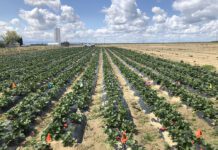Stressed trees and pest outbreaks in large orchards are not always easy to see with “on the ground inspections.” Time and cost for labor in checking orchards comes into play. There is also the possibility of an incorrect diagnosis. Identifying problem trees or areas and determining reason for tree stress can now be done with aerial drone technology.
Aerial Drone Technology
Chris Lawson, development manager for Aerobotics, a Cape Town based AgriTech startup, said aerial drone technology can assist growers and farm managers in identifying health or pest problem areas in large orchards. The company was co-founded by James Paterson (CEO) and Benji Meltzer (CTO) in 2014.
In Lawson’s presentation at the first annual Crop Consultant Conference, he said drones, combined with machine learning algorithms identify areas in orchards where pest and disease are potentially present. Lawson said the drones could survey large areas, providing timely data on 600-700 acres a day. The level of detail is high, he added, allowing for quick adjustments in nutrition or pest control to prevent crop losses.
While irrigators might report “a rough looking area about three rows from the end,” camera carrying drones can pinpoint location of individual trees or orchard zones exhibiting stress-related problems. With that information, growers or orchard managers can fix the problem early, saving labor costs and averting yield losses.
Multi Rotor Drones
Lawson said Aerobotics uses multi rotor drones that are equipped with two types of cameras: visual and multi-spectral. The visual cameras capture tree counts and missing trees. The multi spectral cameras provide per tree analytics including health, canopy, volume and height, and NDVI—normalized difference vegetation index. This index assesses crop vigor based on a mathematical interpretation of color and near infrared data. Cost for the initial data collection flight is $12 per acre.
Individual trees under significant stress and areas where groups of trees are stressed are identified in images that can help growers pinpoint orchard areas for scouting and sampling operations.
Scouting orchards for diseases, pest problems or nutrient deficiencies without the drone-collected data can be time consuming and not cost effective, Lawson said. The images from the drones will allow for building zones in an orchard where tissue samples can be taken and insect pests can be monitored. Lawson said a citrus grower who suspected a chlorosis problem in a small area, found out nearly 400 trees were affected after using the aerial drone technology.
The trees were young and the grower was able to remedy the problem, before yields were affected. A similar scenario found a much more extensive shot hole problem in an almond orchard for a grower.
Scouting App
Lawson said Aerobotics also has a new scouting app to assist with reporting orchard health. Aeroview InField is a data-capturing app for pest and disease management. The app benchmarks crop monitoring with visuals that might be overlooked with in-person scouting. The app has a tree detection algorithm that leads to the stressed trees. Once the data has been collected, growers can take on further on-the-ground assessments and crop treatments. Coupled with the high-resolution drone data, a scout route can be created for on the ground assessments.
The change from Aerobotics’ initial app, Aeroview Scout, is that more than one marker per tree can be added. This allows for multiple data points and more precise data capturing. Markers can be accompanied by custom notes, photos taken on your smartphone and qualifying data of in-field problems.
Improved reporting structures with custom thresholds for pests can be shared. Weekly reports can be downloaded in various formats. The new app can facilitate upcoming software developments such as Drone Scouting. Drone scouting allows farmers who own and fly drones to collect data when needed. The tool is used to control the drone and position it within a five-meter range of stressed trees to capture a 360-degree visual of each tree. Thereafter, the data is interpreted to identify problems without farmers having to walk into the orchard.
KARE Drone Usage
Drone technology is being used at the UC Kearney Agricultural Research and Education Center (KARE). A University of California (UC) Davis Department of Plant Science blog reported that Cooperative Extension agricultural engineering advisor Ali Pourreeza has been using a camera-equipped drone and using photogrammetry and software to make a three dimensional point cloud model of an orchard.
Blogger Jeanette Warnert wrote that the computer program could make colors that are invisible to the human eye—near infrared, red edge and ultraviolet—into imagery that showed key crop health indicators. Near infrared indicates the amount of healthy foliage, plant vigor and crop type. If the trees have low near infrared values, it means the plants are under stress. Red edge indicates plant stress and nitrogen content. High red edge values indicate nitrogen stress and low water content in plant tissues. By looking at the previously invisible colors, growers can manage orchards for optimum production and efficiency.

Cecilia Parsons
Cecilia Parsons has lived in the Central Valley community of Ducor since 1976, covering agriculture for numerous agricultural publications over the years. She has found and nurtured many wonderful and helpful contacts in the ag community, including the UCCE advisors, allowing for news coverage that focuses on the basics of food production.
She is always on the search for new ag topics that can help growers and processors in the San Joaquin Valley improve their bottom line.
In her free time, Cecilia rides her horse, Holly in ranch versatility shows and raises registered Shetland sheep which she exhibits at county and state fairs during the summer.
















